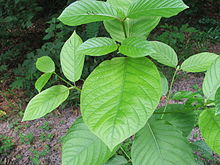Kratom
| Mitragyna speciosa | |
|---|---|
 |
|
| Scientific classification | |
| Kingdom: | Plantae |
| (unranked): | Angiosperms |
| (unranked): | Eudicots |
| (unranked): | Asterids |
| Order: | Gentianales |
| Family: | Rubiaceae |
| Subfamily: | Cinchonoideae |
| Tribe: | Naucleeae |
| Genus: | Mitragyna |
| Species: | M. speciosa |
| Binomial name | |
|
Mitragyna speciosa (Korth.) Havil. |
|
| Synonyms | |
|
|
Mitragyna speciosa Korth. (commonly known as kratom, also ketum), is a tropical evergreen tree in the coffee family (Rubiaceae) native to Southeast Asia in the Indochina and Malaysia (botanical regions). M. speciosa is indigenous to Thailand, Indonesia, and Malaysia, Myanmar, and Papua New Guinea where it has been used in traditional medicine since at least the nineteenth century. Kratom has some opiate and stimulant like properties.
As of 2013 no clinical trials had been done to understand kratom's health effects and it had no approved medical uses. Some people take it for managing chronic pain, for treating opioid withdrawal symptoms, or – more recently – for recreational purposes. Onset of effects typically begin within 5 to 10 minutes and last 2 to 5 hours.
Minor side effects may include nausea, vomiting, and constipation. More severe side effects may include seizure, addiction, and psychosis. Other side effects include high heart rate and blood pressure, liver toxicity, and trouble sleeping. When use is stopped withdrawal may occur.Respiratory depression (decreased breathing) is a major risk with all opiates; the medical literature is divided on whether it is a significant side effect of kratom, with some authorities not mentioning it and others emphasizing it. When mixed with other substances, kratom use has resulted in death. In the United States, there were fifteen kratom-related deaths between 2014 and 2016, although in none was kratom the sole factor.
...
Wikipedia
